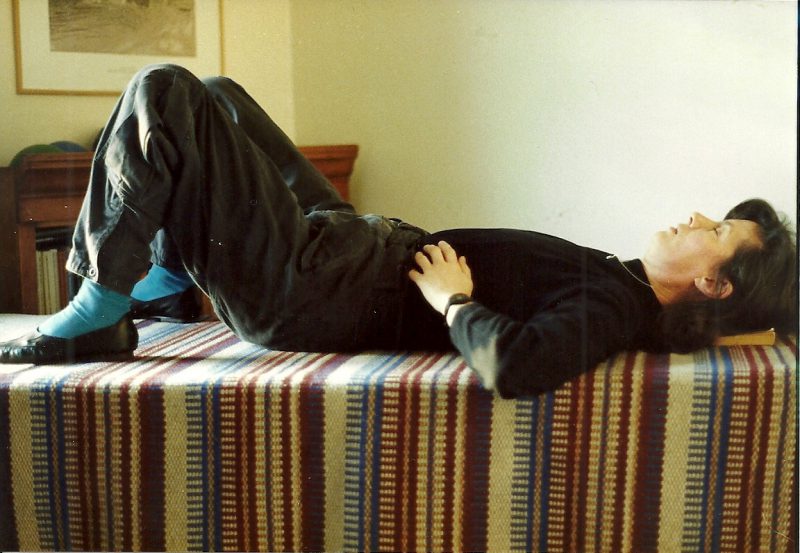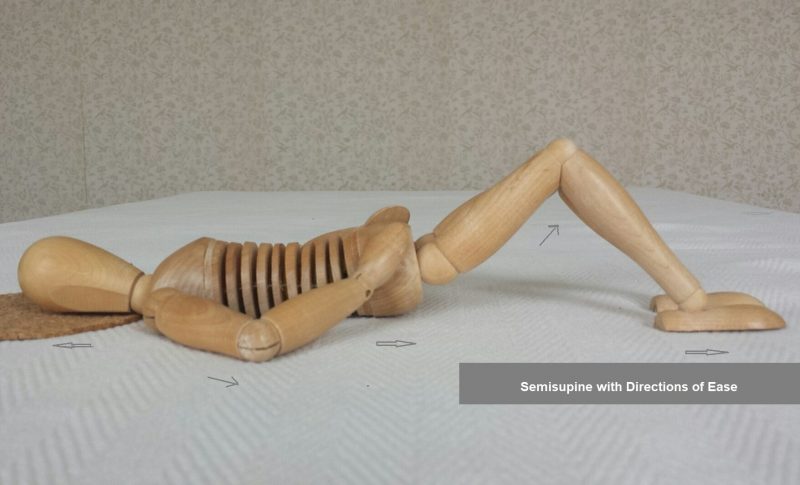Alexander Technique Lying Down Procedure
Also known as:
Semi-Supine; Active Rest; Constructive Rest Procedure; ‘Inhibition Work’.
When F M Alexander was running his training school, there was no table available, so the lying down procedure took place on the floor and that is how we practise it at home. These days, teachers use a table during lessons. According to Elisabeth Walker who trained with him, Alexander used to call the lying down procedure ‘inhibition work‘ (Forward and Away ~ Elisabeth Walker 2008). This illustrates the fact that our thinking is all-important during this procedure, in order to stop any reactions of tightening that occur whilst we are lying down.
‘You are doing what you call “leaving yourself alone’
F M Alexander – Aphorisms – Mouritz 2000

Lying Down in Semi-Supine
Do this procedure on the floor but not the bed as it is too soft and will not give you enough support in the right places. If you are physically unable to get up and down from the floor, then by all means use the bed. Place the number of books that your teacher suggested you need, under your head, so that your neck and spine are able to lengthen out freely without arching.
To start with, choose a warm, quiet room to lie down in. Over time you want to be able to work on yourself in many different places, such as up the garden. Learn to train your thinking and allow yourself to return to a quiet, expansive state – a good stress management skill to develop!
Twenty Minutes a Day – Unless you are over 28 Weeks Pregnant
Give your body time to unwind and decompress. You need to give this process about 20 minutes. If this is really difficult for you, then start off with at least 10 minutes and try to extend the period you lie down.
However, if you are over 28 weeks pregnant, the NHS advises that lying on your back can put pressure on the baby so should be avoided. You can use all the same thinking whilst lying on your side and you can use procedures will Wall Work to help ease your back.
The Act of Lying Down
First of all stop, say ‘no’ and inhibit your usual way of going to lie down. Think about how you are going to move and keep using inhibition all the way through the procedure.
With awareness, give yourself directions and begin to lie down on your back with your knees bent, moving into the semi-supine position, as above. Take care not to arch your neck back and down onto your books, but remind yourself to direct your head forward and up so that you gently maintain the spine’s length as you move.
Check that you have a free neck. Then think about how you will bend your knees but inhibit any tightening and distorting that interferes with the movement, then freely bend your knees out and away from your hip joints. Place your feet on the floor as wide apart as your hips are so that your hips, knees and feet are in line with each other. Take care to align your feet so that they do not turn in, nor out further than your knees.
However, remember that how you are, is much more important than your exact position. Do not lock and fix yourself so that you can hold the ‘right’ position and say ‘no’ to any impulse you have to wriggle around and re-adjust your position.
‘There is no such thing as a right position, but there is such a thing as a right direction’
F M Alexander – Aphorisms – Mouritz 2000
Continue to give yourself directions and place your hands on your ribcage, with your elbows directing out and away from each other.
Allow your back to drop down to the floor and to gently lengthen out. Do not force anything but allow the changes to take place as you give yourself directions.
Thinking and Directing
Now you can begin to practice the thinking skills developed in the Alexander Technique. Allow your mind and body to quieten but remain alert with your eyes open; direct yourself to release contracted muscles so that they can lengthen out again and inhibit any urge to move around or tighten up again.
- Allow my neck to be free
- Allow my head ease to forward and up
- Allow my back to lengthen and widen
- Allow my knees to ease out and away
As you continue to give yourself directions, you will bring about changes in your habits and use which you aim to continue throughout everyday activities. You are not actively doing anything; it is all ‘mind over matter’. You need an alert mind, not switched off or sleepy, but ‘working on yourself’. In this way you gain a deeper understanding and subtle, conscious control over your use and your thinking. Remain aware of the outside world, whilst developing inner awareness and giving yourself directions.
Allow your body to ease in the directions of the arrows

When your mind wanders, come back to being aware of what is going on in your body. It can help to recognize the links between your thoughts, feelings and bodily reactions. Perhaps you have started tightening up again in response to something you thought about? If so, when you recognise your reaction patterns, let go of those habits and connect with places of ease in yourself. Avoid wriggling around but lie still, easy and alert. Allow yourself to return to a quiet, neutral state so your body eases into its full length and width. Your mind and nervous system will quieten and you will breathe more freely.
Give yourself directions and allow yourself to experience being – just as you are.
Getting up from the floor
Please get up from the floor thoughtfully and slowly, so that you can avoid light-headeness and dizziness that can occur with postural hypotension.
When you wish to get up again, maintain any quietness, release and lengthening that you have experienced and take these with you into your movements. Say ‘no’ to any habits of mis-use that may start to reappear as you begin to become active again, then continue your directions and move freely and expansively as you get up from the floor.
Look over into the direction you wish to move and allow your head to follow your eyes, then bring your arm over your body to that side of you. Gently begin to roll over, with your hips knees and shoulders moving together, so that you avoid twisting your torso.
Roll onto your side and continue to roll over, keeping your knees bent, so that you end up on all fours (in a crawling position) with your back lengthened and your head in alignment with the rest of your spine.
Giving yourself directions to have a free neck and maintaining the length in your spine whilst moving, quietly bring yourself into a kneeling position.
Continue to give directions and say ‘no’ to standing up without thought. Move into a high kneel then allow your head to lead you into movement as you rise to stand on two feet.
- Remember: Stop and Inhibit ~ Think and Direct ~ Then Move
Still unsure about some aspects of the procedure?
Alexander Technique Lying Down Procedure: FAQ
You can see a video produced by STAT, talking you through the Lying Down Procedure:
https://www.youtube.com/watch?time_continue=21&v=NhxMNou1Tfo
As a new pupil put it in an email to me – ‘I’ve had a very stressful day so I’m going to do some lying down! It really does help to ease the tension’